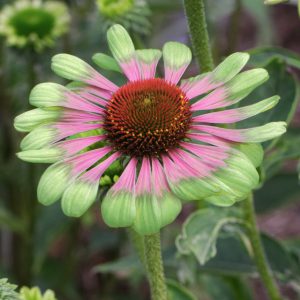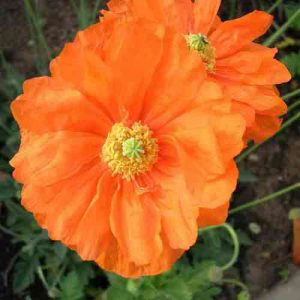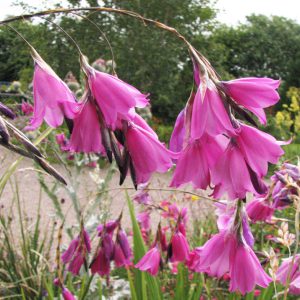- 1-9 pkts $4.50
- 10 pkts FREE
- Express post $12
Sanguisorba officinalis ‘Little Red Tanna’
LITTLE RED TANNA BURNET
Sanguisorba officinalis ‘Little Red Tanna’ trembles in the summer air with a dense flock of vivid raspberry cones.
Not permitted for entry to WA
A summer cloud of raspberry bobbles
Although each head is a small bobble, there are literally hundreds and hundreds of them floating in a haze. So the whole effect is fine, willowy and airy.
(Please see “Growing” section below for plant details, how & where to grow)
Dainty fine foliage
Small leaflets also make particularly fine and dainty foliage. So enhancing the lacy “see through” look of Sanguisorba officinalis ‘Little Red Tanna’.
Superb cut flowers
You can cut armloads of the frothy, airy stems.
The raspberry cones will last for ages in a vase while also setting off larger blooms in the arrangement.
Hardy & easy to grow
Sanguisorba officinalis ‘Little Red Tanna’ grows from a thick rhizome type root base, giving it the toughness to withstand set-backs and overcome difficulties.
SEED SOWING ADVICE: QUICK & EASY
Sow seeds of Sanguisorba officinalis ‘Little Red Tanna’ at any time of year in a punnet indoors, whenever suitable temperatures can be provided / or scatter directly in the garden in winter, spring & autumn.
Sow indoors for quick & early plants: First sow the seed in a punnet on surface of good quality seed raising mix.
Then gently pat the seed to the surface of the mix to ensure good contact.
Now barely dust with fine mix/fine sand but do not bury.
Because these seeds need light for germination.
Now thoroughly moisten the mix by standing the punnet in a shallow water bath and allowing the moisture to percolate through to the surface of the mix from below.
Then place the punnet in a warm, well lit position (not in any direct sunlight).
Temperatures of 15-20°C approx. are best for rapid and optimum germination.
Continue to keep the punnet moist by misting from a spray water bottle.
Covering the punnet with a plastic lid or bag will also help maintain consistent moisture and prevent drying out.
Seedlings emerge in approx. 14-30 days.
However if the seeds are shy to germinate – then they need a period of chilling to break their natural dormancy.
So cling wrap the moist punnet. Place in fridge (not freezer) for 4-6 weeks. Then remove, unwrap & return to well-lit position at 15-20°C. Continue to keep moist for germination.
Seed Count: 12 seeds per pack approx.
(We always aim to exceed the stated count and give a generous serve).
GROWING: Sanguisorba officinalis ‘Little Red Tanna’
Height with flowers: Upright strong stems to approx. 30cm. A compact plant to really impress.
Width: A graceful, compact clump 30cm. Wide approx.
Position: Full Sun to Part Shade / Dappled Sun is all agreeable to unfussy Sanguisorba officinalis. Some afternoon shade could be appreciated in very hot areas.
Suitable for seaside gardens.
Hardy & easy to grow
Soil: Sanguisorba officinalis is not at all fussy, and so will cope in all different soils, from sandy to clay and all between. Happily for gardeners with heavy and clay soils which can become quite wet in winter, it even thrives here.
Sanguisorba is not a hungry plant, so average garden soil is perfectly adequate, and heavy fertilizing should not be given.
It is not phased by soils on either the acid or alkaline (lime) side of neutral, and is particularly forgiving of soils with a high lime content.
Frost: Extremely frost hardy, so it is capable of withstanding frosts to well below -15C.
Water: Sanguisorba officinalis is not a thirsty plant, so normal, average garden watering is all that is required. The tough, rhizome-like root clump allows it to withstand variations in watering.
Low maintenance
Care: Easy growing, low maintenance plant. Therefore the only real annual work is to cut the spent foliage clump back at the end of autumn to tidy up (or you can leave it to early spring if you wish).
In addition for the low maintenance gardener, Sanguisorba officinalis is usually untroubled by any pests and diseases.
Other benefits
Growth: Hardy perennial clump which has a lovely golden autumn colour change, is dormant over winter, before shooting again in the spring with lovely, refined ferny foliage, then flowering in summer-autumn with spectacular clouds of flowers.
Beneficial for wildlife: The clouds of hundreds of flowers are very attractive to bees, butterflies and moths. They are always buzzing busy gathering nectar.
Fragrance: Sadly none – but it has no other sins.
Deer & Rabbit resistant: While the flavour of Sanguisorba officinalis is tasty to humans, fortunately it is not particularly appealing to rabbits or deer.
Tasty kitchen herb
Origin: Sanguisorba officinalis in its various forms occurs right across the northern hemisphere, including Asia, Europe, and North America. So indicating just what a hardy and adaptable plant Sanguisorba officinalis is. ‘Little Red Tanna’ is a modern garden cultivar of the original wild species.
Edible kitchen uses: Sanguisorba officinalis has a long history of herbal and culinary use in Europe.
Where the young fresh leaves, with their cucumber-like flavour, have been used for centuries in salads, sandwiches and soups.
However herbalists usually warn against consuming Sanguisorba during pregnancy.
Though some organic farmers swear by it as a tonic for their cattle, and grow fields of it for winter fodder in Europe.
And an ancient medicine
Traditional herbal uses: Sanguisorba officinalis has a long history of use in both traditional Chinese medicine and historic western practice. It was used as an astringent to staunch flow of fluids, and as a tonic for the blood. There has even been some 21st century research into HIV treatments that may indicate some anti-viral properties.
Named in blood
Botanical name: The name of Sanguisorba officinalis comes from Latin. So “sanguis” means “blood”; “sorbeo”, means “to staunch”; and “officinalis” indicates used by medieval healers.
Click here for Nursery Open Days & Open Gardens Information
https://www.gardivalia.com.au/open-gardens
Click here to go back to Seeds Shop
https://www.seedscape.net.au/shop/
Related products
-
Add to WishlistAlready In WishlistAdd to Wishlist
-
Add to WishlistAlready In WishlistAdd to Wishlist
-
Add to WishlistAlready In WishlistAdd to Wishlist
-
All
Dierama pulcherrimum
‘Rose Pink’
ROSE PINK
FAIRY FISHING RODS
SALE: Buy 1 get 2 packs
$5.00 AUD Add to cartAdd to WishlistAlready In WishlistAdd to Wishlist






